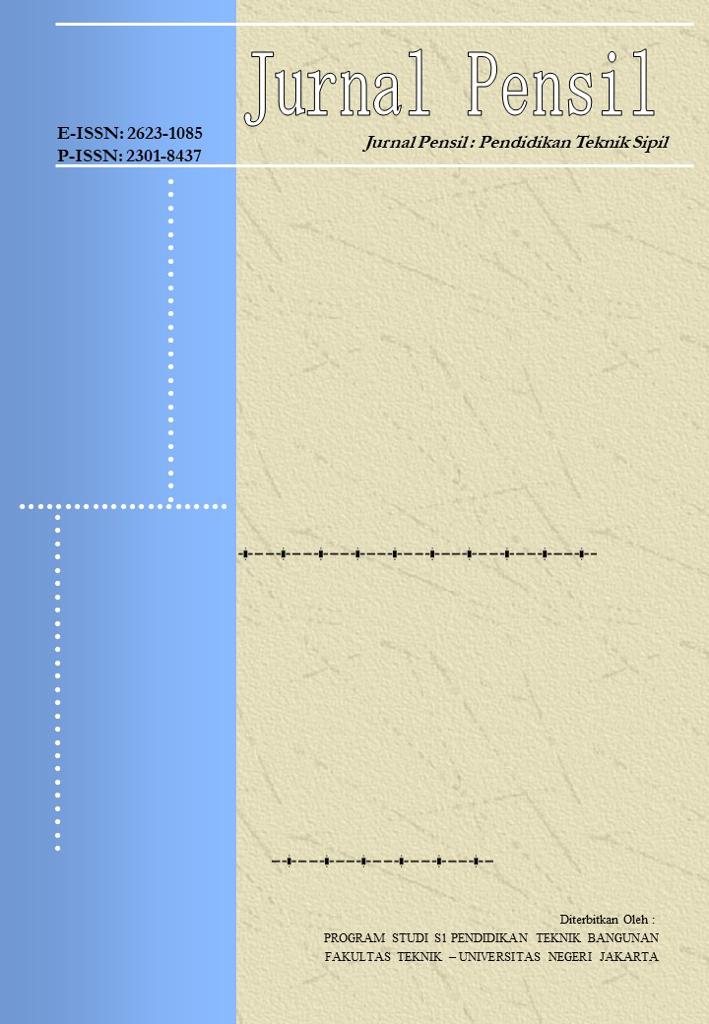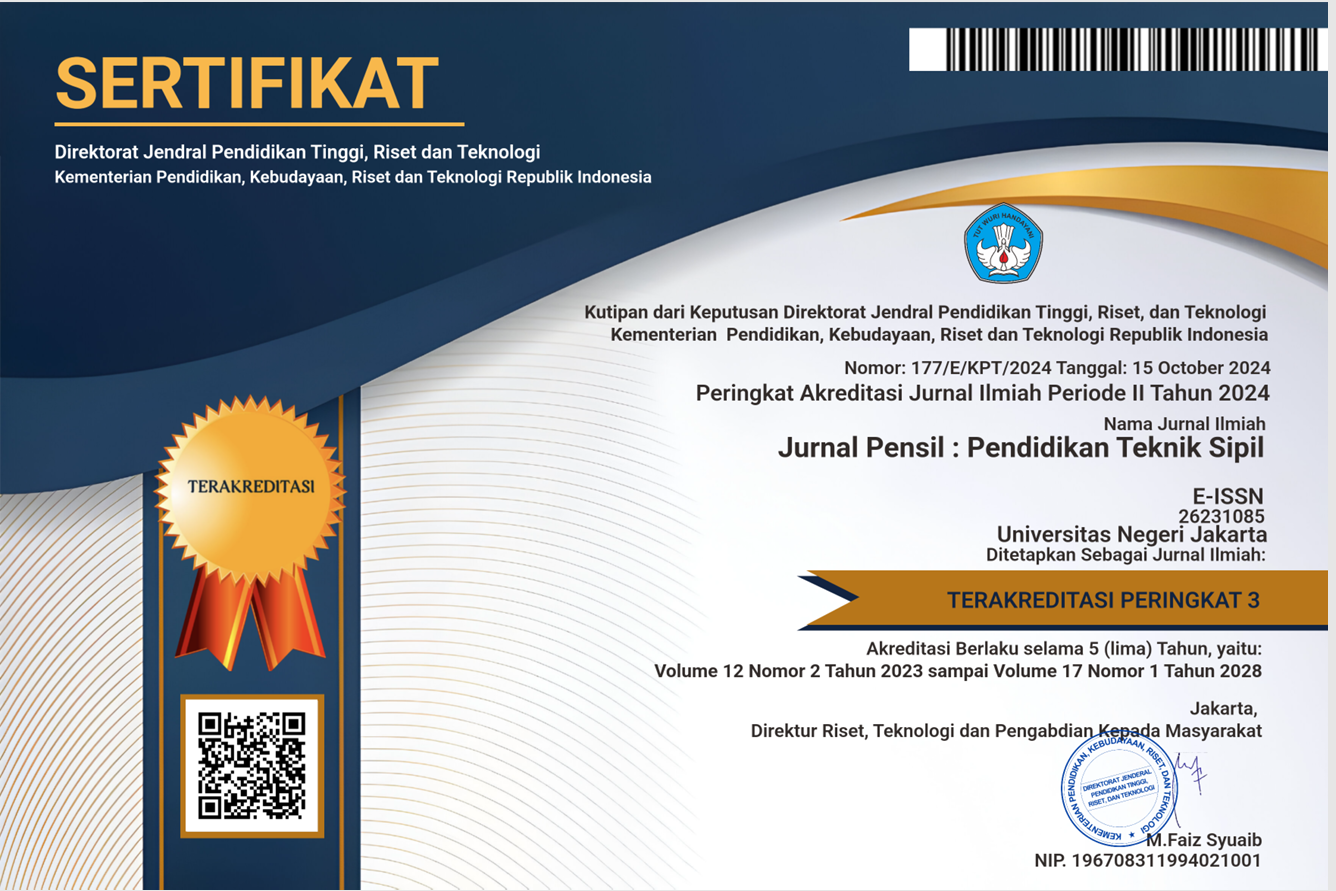THE EFFECT OF ALKALI ACTIVATOR MOLARITY ON THE MECHANICAL PERFORMANCE OF GEOPOLYMER PAVING BLOCKS BASED ON WASTE GLASS POWDER AND FLY ASH
DOI:
https://doi.org/10.21009/jpensil.v14i1.50676Keywords:
Fly ash, Glass Powder, NaOH, Geopolymer Paving BlockAbstract
The effect of concentration of sodium hydroxide (NaOH) on physical and mechanical properties of geopolymer paving blocks consist of fly ash type F and glass powder. A quantitative experimental method was used both the NaOH molarity (1M, 2M, 4M, 6M, 8M and 10M) was studied and the compressive strength, flexure strength and water absorption were taken as key parameters. The ratio of alkali activator to binder was 0.35, and the ratio of Sodium Silicate/NaOH was 1.5. The best performance at 4M molarity yielded compressive strength of 35.60 MPa and flexural strength of 4.29 MPa, due to optimal geopolymerization and denser microstructure. The mechanical performance of the geopolymer paving blocks was compromised at NaOH molarities higher than 4M due to the emergence of a micropore, which increased the porosity and water absorption from 6.55% at 1M to 9.14% at 10M. These results confirm that increasing NaOH molarity is vital for producing geopolymer paving block with high performance. Hence, this study contributes to sustainable construction by using waste products of industries for producing construction and building materials.
References
Abed, H. S., Al-Saffar, Z. H., & Hamad, A. J. (2024). Synergistic effect of the silica fume and glass powder as pozzolanic materials in cement mortar. International Journal of Sustainable Building Technology and Urban Development, 15(1), 43–56. https://doi.org/10.22712/susb.20240004
Ahmaruzzaman, M. (2010). A review on the utilization of fly ash. Progress in Energy and Combustion Science, 36(3), 327–363. https://doi.org/10.1016/j.pecs.2009.11.003
Aziz, A., Mehboob, S. S., Tayyab, A., Khan, D., Hayyat, K., Ali, A., & Latif Qureshi, Q. B. I. (2024). Enhancing sustainability in self-compacting concrete by optimizing blended supplementary cementitious materials. Scientific Reports, 14(1), 12326. https://doi.org/10.1038/s41598-024-62499-w
Belviso, C., Cavalcante, F., Di Gennaro, S., Palma, A., Ragone, P., & Fiore, S. (2015). Mobility of trace elements in fly ash and in zeolitised coal fly ash. Fuel, 144, 369–379. https://doi.org/10.1016/j.fuel.2014.12.037
Bostanci, L. (2020). Effect of waste glass powder addition on properties of alkali-activated silica fume mortars. Journal of Building Engineering, 29, 101154. https://doi.org/10.1016/j.jobe.2019.101154
Chen, P., Zhang, S., Meng, J., Lei, T., Li, B., & Coffman, D. (2023). Technological Solutions to China’s Carbon Neutrality in the Steel and Cement Sectors. Earth’s Future, 11(9). https://doi.org/10.1029/2022EF003255
Cheng, D., Reiner, D. M., Yang, F., Cui, C., Meng, J., Shan, Y., Liu, Y., Tao, S., & Guan, D. (2023). Projecting future carbon emissions from cement production in developing countries. Nature Communications, 14(1), 8213. https://doi.org/10.1038/s41467-023-43660-x
Davidovits, J. (2015). Geopolymer Institute Library. Technical paper #24, False-CO2-values. http://www.materialstoday.com/polymers-soft-materials/features/environmental-implications-of-geopolymers/,
Fareeddahmeddmemon. (2013). EFFECTTOFFSODIUMMHYDROXIDEECONCENTRATIONNONN FRESHHPROPERTIESSANDDCOMPRESSIVEESTRENGTHHOFF SELF-COMPACTINGGGEOPOLYMERRCONCRETEE (Vol. 8).
Gao, X., Yao, X., Xie, R., Li, X., Cheng, J., & Yang, T. (2022). Performance of fly ash-based geopolymer mortars with waste cathode ray tubes glass fine aggregate: A comparative study with cement mortars. Construction and Building Materials, 344. https://doi.org/10.1016/j.conbuildmat.2022.128243
Gholampour, A., Ho, V. D., & Ozbakkaloglu, T. (2019). Ambient-cured geopolymer mortars prepared with waste-based sands: Mechanical and durability-related properties and microstructure. Composites Part B: Engineering, 160, 519–534. https://doi.org/10.1016/j.compositesb.2018.12.057
Gomes Silveira, N. C., Figueiredo Martins, M. L., Bezerra, A. C. da S., & Gabriel da Silva Araújo, F. (2022). Ecological geopolymer produced with a ternary system of red mud, glass waste, and Portland cement. Cleaner Engineering and Technology, 6. https://doi.org/10.1016/j.clet.2021.100379
Jiang, X., Xiao, R., Bai, Y., Huang, B., & Ma, Y. (2022). Influence of waste glass powder as a supplementary cementitious material (SCM) on physical and mechanical properties of cement paste under high temperatures. Journal of Cleaner Production, 340, 130778. https://doi.org/10.1016/j.jclepro.2022.130778
Jonbi, J., & Fulazzaky, M. A. (2020). Modeling the water absorption and compressive strength of geopolymer paving block: An empirical approach. Measurement: Journal of the International Measurement Confederation, 158. https://doi.org/10.1016/j.measurement.2020.107695
Joseph Davidovits. (1994). Environmental implications of Geopolymers - Materials Today. https://www.materialstoday.com/polymers-soft-materials/features/environmental-implications-of-geopolymers/
Ju, M., Rashid, K., Zafar, I., & Ltifi, M. (2023). Developing FA-based cementless binder composite by opting sustainable technology: Application of brick and paving block. Engineering Science and Technology, an International Journal, 48. https://doi.org/10.1016/j.jestch.2023.101580
Klimont, Z., Kupiainen, K., Heyes, C., Purohit, P., Cofala, J., Rafaj, P., Borken-Kleefeld, J., & Schöpp, W. (2017). Global anthropogenic emissions of particulate matter including black carbon. Atmospheric Chemistry and Physics, 17(14), 8681–8723. https://doi.org/10.5194/acp-17-8681-2017
Kusuma, A., Steenie, P., Wallah, E., & Dapas, S. O. (2014). KUAT TARIK BELAH BETON GEOPOLYMER BERBASIS ABU TERBANG (FLY ASH). Jurnal Sipil Statik, 2(7), 330–336.
Lanzerstorfer, C. (2018). Fly ash from coal combustion: Dependence of the concentration of various elements on the particle size. Fuel, 228, 263–271. https://doi.org/10.1016/j.fuel.2018.04.136
Li, A., Qiao, H., Li, Q., Hakuzweyezu, T., & Chen, B. (2021). Study on the performance of pervious concrete mixed with waste glass powder. Construction and Building Materials, 300, 123997. https://doi.org/10.1016/j.conbuildmat.2021.123997
Liu, F., Zhang, Q., Tong, D., Zheng, B., Li, M., Huo, H., & He, K. B. (2015). High-resolution inventory of technologies, activities, and emissions of coal-fired power plants in China from 1990 to 2010. Atmospheric Chemistry and Physics, 15(23), 13299–13317. https://doi.org/10.5194/acp-15-13299-2015
Luo, Y., Wu, Y., Ma, S., Zheng, S., Zhang, Y., & Chu, P. K. (2021). Utilization of coal fly ash in China: a mini-review on challenges and future directions. Environmental Science and Pollution Research, 28(15), 18727–18740. https://doi.org/10.1007/s11356-020-08864-4
Mahdi, F., Abbas, H., & Khan, A. A. (2010). Strength characteristics of polymer mortar and concrete using different compositions of resins derived from post-consumer PET bottles. Construction and Building Materials, 24(1), 25–36. https://doi.org/10.1016/j.conbuildmat.2009.08.006
Mahdi, S. N., Babu R, D. V., Hossiney, N., & Abdullah, M. M. A. B. (2022). Strength and durability properties of geopolymer paver blocks made with fly ash and brick kiln rice husk ash. Case Studies in Construction Materials, 16. https://doi.org/10.1016/j.cscm.2021.e00800
Marathe, S., Sadowski, Ł., & Shree, N. (2024). Geopolymer and alkali-activated permeable concrete pavements: Bibliometrics and systematic current state of the art review, applications, and perspectives. In Construction and Building Materials (Vol. 421). Elsevier Ltd. https://doi.org/10.1016/j.conbuildmat.2024.135586
Matos, A. M., Milheiro-Oliveira, P., & Pimentel, M. (2024). Eco-efficient high performance white concrete incorporating waste glass powder. Construction and Building Materials, 411, 134556. https://doi.org/10.1016/j.conbuildmat.2023.134556
Nath, S. K. (2020). Fly ash and zinc slag blended geopolymer: Immobilization of hazardous materials and development of paving blocks. Journal of Hazardous Materials, 387. https://doi.org/10.1016/j.jhazmat.2019.121673
Omran, A., Soliman, N., Zidol, A., & Tagnit-Hamou, A. (2018). Performance of Ground-Glass Pozzolan as a Cementitious Material—A Review. Advances in Civil Engineering Materials, 7(1), 237–270. https://doi.org/10.1520/ACEM20170125
Ranjbar, N., & Kuenzel, C. (2017). Cenospheres: A review. Fuel, 207, 1–12. https://doi.org/10.1016/j.fuel.2017.06.059
Shen, P., Zheng, H., Liu, S., Lu, J.-X., & Poon, C. S. (2020). Development of high-strength pervious concrete incorporated with high percentages of waste glass. Cement and Concrete Composites, 114, 103790. https://doi.org/10.1016/j.cemconcomp.2020.103790
Srividya, T., Kannan Rajkumar, P. R., Sivasakthi, M., Sujitha, A., & Jeyalakshmi, R. (2022). A state-of-the-art on development of geopolymer concrete and its field applications. Case Studies in Construction Materials, 16. https://doi.org/10.1016/j.cscm.2021.e00812
Sunarsih, E. S., As’ad, S., Mohd. Sam, A. R., & Kristiawan, S. A. (2023). The effect of sodium hydroxide molarity on setting time, workability, and compressive strength of fly ash-slag-based geopolymer mortar. Journal of Physics: Conference Series, 2556(1). https://doi.org/10.1088/1742-6596/2556/1/012019
Sunarsih, E. S., As’ad, S., Sam, A. R. M., & Kristiawan, S. A. (2023). Properties of Fly Ash-Slag-Based Geopolymer Concrete with Low Molarity Sodium Hydroxide. Civil Engineering Journal (Iran), 9(2), 381–392. https://doi.org/10.28991/CEJ-2023-09-02-010
Tchakouté, H. K., Rüscher, C. H., Kong, S., Kamseu, E., & Leonelli, C. (2016). Geopolymer binders from metakaolin using sodium waterglass from waste glass and rice husk ash as alternative activators: A comparative study. Construction and Building Materials, 114, 276–289. https://doi.org/10.1016/j.conbuildmat.2016.03.184
Uliasz-Bocheńczyk, A., & Mokrzycki, E. (2020). The potential of FBC fly ashes to reduce CO2 emissions. Scientific Reports, 10(1), 9469. https://doi.org/10.1038/s41598-020-66297-y
Xi, F., Davis, S. J., Ciais, P., Crawford-Brown, D., Guan, D., Pade, C., Shi, T., Syddall, M., Lv, J., Ji, L., Bing, L., Wang, J., Wei, W., Yang, K.-H., Lagerblad, B., Galan, I., Andrade, C., Zhang, Y., & Liu, Z. (2016). Substantial global carbon uptake by cement carbonation. Nature Geoscience, 9(12), 880–883. https://doi.org/10.1038/ngeo2840
Xu, G., & Shi, X. (2018). Characteristics and applications of fly ash as a sustainable construction material: A state-of-the-art review. Resources, Conservation and Recycling, 136, 95–109. https://doi.org/10.1016/j.resconrec.2018.04.010
Yao, Z. T., Ji, X. S., Sarker, P. K., Tang, J. H., Ge, L. Q., Xia, M. S., & Xi, Y. Q. (2015). A comprehensive review on the applications of coal fly ash. Earth-Science Reviews, 141, 105–121. https://doi.org/10.1016/j.earscirev.2014.11.016
Zhang, H. Y., Yan, J., Kodur, V., & Cao, L. (2019). Mechanical behavior of concrete beams shear strengthened with textile reinforced geopolymer mortar. Engineering Structures, 196. https://doi.org/10.1016/j.engstruct.2019.109348
Zhang, Q., Streets, D. G., He, K., Wang, Y., Richter, A., Burrows, J. P., Uno, I., Jang, C. J., Chen, D., Yao, Z., & Lei, Y. (2007). NO x emission trends for China, 1995–2004: The view from the ground and the view from space. Journal of Geophysical Research: Atmospheres, 112(D22). https://doi.org/10.1029/2007JD008684
Zhao, L., Dai, S., Finkelman, R. B., French, D., Graham, I. T., Yang, Y., Li, J., & Yang, P. (2020). Leaching behavior of trace elements from fly ashes of five Chinese coal power plants. International Journal of Coal Geology, 219, 103381. https://doi.org/10.1016/j.coal.2019.103381
Żyrkowski, M., Neto, R. C., Santos, L. F., & Witkowski, K. (2016). Characterization of fly-ash cenospheres from coal-fired power plant unit. Fuel, 174, 49–53. https://doi.org/10.1016/j.fuel.2016.01.061
Downloads
Published
How to Cite
Issue
Section
License
Copyright (c) 2025 Adji Putra Abriantoro, Manlian Ronald Adventus Simanjuntak

This work is licensed under a Creative Commons Attribution-ShareAlike 4.0 International License.











.png)
.png)
1.png)

